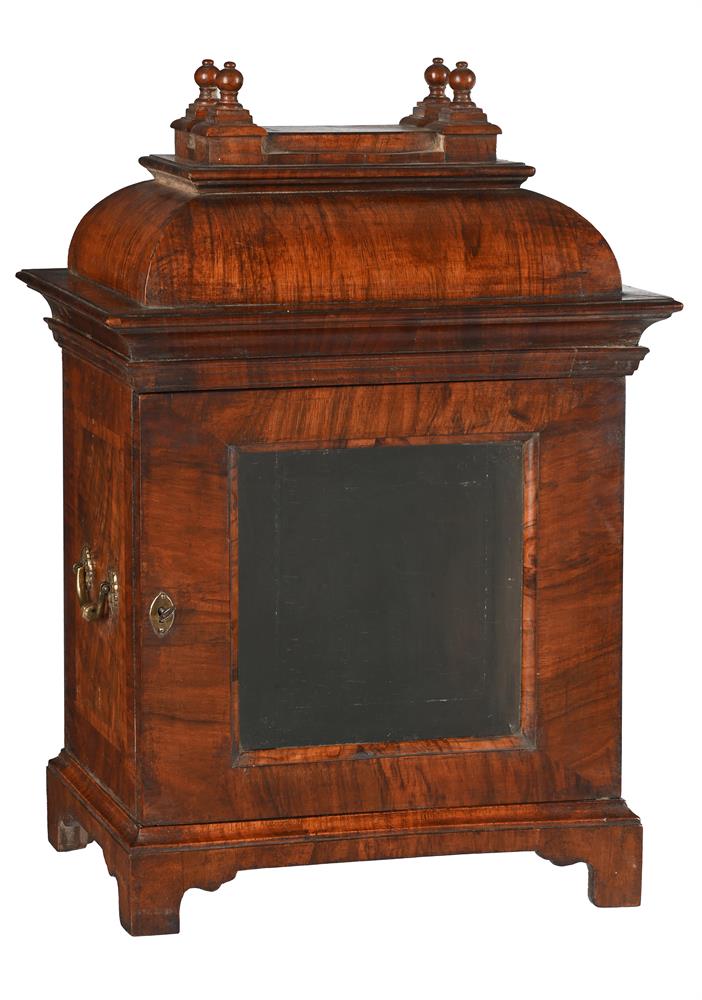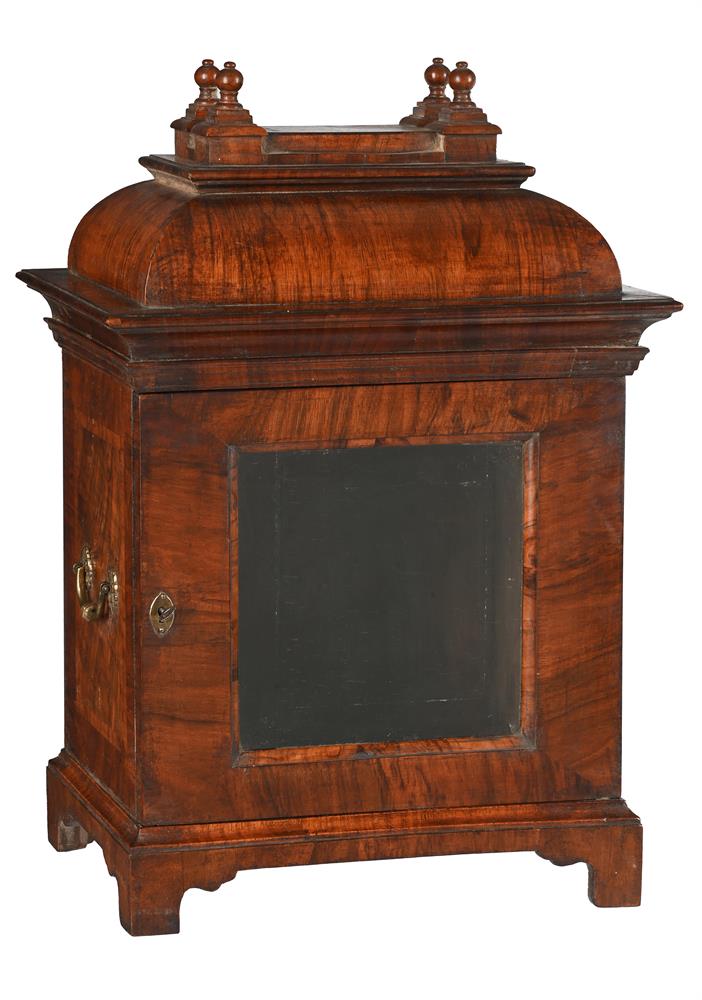AN UNUSUAL ENGLISH GILT BRASS SMALL MOONPHASE CALENDAR CARRIAGE CLOCK WITH TANDEM-DRIVE BARREL UNSIGNED, MID 19th CENTURY The eight-day four pillar two train bell striking movement with single spring barrel incorporating opposing tandem greatwheels for driving both trains, the going train with offset underslung platform lever escapement regulated by sprung monometallic balance, the fine gilt twin bird inhabited foliate scroll engraved rectangular dial with rolling moonphase aperture to centre, incorporating silvered 'button moon' to the revolving matted lunar disc annotated for the age-of-the-moon to upper margin and with rosette engraved lunettes to infill beneath, within Roman numeral chapter ring and with blued steel spade hands over twin subsidiary day-of-the-week and date-of-the-month dials within fine engraved leafy infill, the case with hinged foliate cast faceted baton carrying handle over inset concave-sided rectangular platform to top and convex cornice mouldings flanked by projecting rounded ogee mouldings forming the caps for the quatrefoil three-quarter column corner uprights, the front and rear with bevel glazed doors and the sides with plain panels, on stepped canted base interrupted by blocks supporting the uprights at the angles over disc feet. 12.5cm (5ins) high with handle down, 9cm (3.5ins) wide, 7cm (2.75ins) deep. The provision of a 'tandem barrel' to drive both the going and strike trains is very unusual and has its roots in 17th century Dutch practice with many 'Haagse' clocks employing this system (see Van Den Ende; Van Kersen-Halbertsma; Taylor, Dr. John C. and Taylor Neil HUYGENS' LEGACY, THE GOLDEN AGE OF THE PENDULUM CLOCK pages 176-177, for an example by Johannes van Ceulen). The natural advantage of this system is to save space which would naturally lend itself to provision within carriage clock work. However is rarely seen with Charles Allix noting that it occurs in some carriage clocks made in the French Dura and also in Austria (see Allix, Charles and Bonnert, Peter CARRIAGE CLOCKS, Their history and development page 416). The form of the case of the present clock follows those made popular by makers such as Arnold and Dent during the 1840's; a case sharing the same handle casting, and stamped for the casemaker L. Lange, is illustrated in Roberts, Derek CARRIAGE and Other Travelling Clocks on page 348 (Figure 24-5). Condition Report: Clock appears complete and in original condition however it is not currently running or striking. The movement does appear essentially 'untouched' and is fully wound hence is most likely gummed-up with dried oil. The hands are 'catching' when advanced indicating that there is an issue with the under-dial work - most likely the strike release. The dial is in good original condition with visible faults limited to some rubbing and wear to the black numerals. We cannot ascertain whether the calendar functions are operational due to the hands 'catching'. The case appears free from visible damage or noticeable replacements and has deep gilt finish exhibiting some patchy discolouration/oxidation, scratching and edge wear. There is no winding key present. Condition Report Disclaimer
AN UNUSUAL ENGLISH GILT BRASS SMALL MOONPHASE CALENDAR CARRIAGE CLOCK WITH TANDEM-DRIVE BARREL UNSIGNED, MID 19th CENTURY The eight-day four pillar two train bell striking movement with single spring barrel incorporating opposing tandem greatwheels for driving both trains, the going train with offset underslung platform lever escapement regulated by sprung monometallic balance, the fine gilt twin bird inhabited foliate scroll engraved rectangular dial with rolling moonphase aperture to centre, incorporating silvered 'button moon' to the revolving matted lunar disc annotated for the age-of-the-moon to upper margin and with rosette engraved lunettes to infill beneath, within Roman numeral chapter ring and with blued steel spade hands over twin subsidiary day-of-the-week and date-of-the-month dials within fine engraved leafy infill, the case with hinged foliate cast faceted baton carrying handle over inset concave-sided rectangular platform to top and convex cornice mouldings flanked by projecting rounded ogee mouldings forming the caps for the quatrefoil three-quarter column corner uprights, the front and rear with bevel glazed doors and the sides with plain panels, on stepped canted base interrupted by blocks supporting the uprights at the angles over disc feet. 12.5cm (5ins) high with handle down, 9cm (3.5ins) wide, 7cm (2.75ins) deep. The provision of a 'tandem barrel' to drive both the going and strike trains is very unusual and has its roots in 17th century Dutch practice with many 'Haagse' clocks employing this system (see Van Den Ende; Van Kersen-Halbertsma; Taylor, Dr. John C. and Taylor Neil HUYGENS' LEGACY, THE GOLDEN AGE OF THE PENDULUM CLOCK pages 176-177, for an example by Johannes van Ceulen). The natural advantage of this system is to save space which would naturally lend itself to provision within carriage clock work. However is rarely seen with Charles Allix noting that it occurs in some carriage clocks made in the French Dura and also in Austria (see Allix, Charles and Bonnert, Peter CARRIAGE CLOCKS, Their history and development page 416). The form of the case of the present clock follows those made popular by makers such as Arnold and Dent during the 1840's; a case sharing the same handle casting, and stamped for the casemaker L. Lange, is illustrated in Roberts, Derek CARRIAGE and Other Travelling Clocks on page 348 (Figure 24-5). Condition Report: Clock appears complete and in original condition however it is not currently running or striking. The movement does appear essentially 'untouched' and is fully wound hence is most likely gummed-up with dried oil. The hands are 'catching' when advanced indicating that there is an issue with the under-dial work - most likely the strike release. The dial is in good original condition with visible faults limited to some rubbing and wear to the black numerals. We cannot ascertain whether the calendar functions are operational due to the hands 'catching'. The case appears free from visible damage or noticeable replacements and has deep gilt finish exhibiting some patchy discolouration/oxidation, scratching and edge wear. There is no winding key present. Condition Report Disclaimer















Testen Sie LotSearch und seine Premium-Features 7 Tage - ohne Kosten!
Lassen Sie sich automatisch über neue Objekte in kommenden Auktionen benachrichtigen.
Suchauftrag anlegen